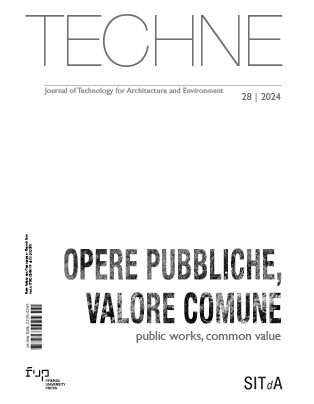Published 2024-10-29
Keywords
- Differentiated integration,
- Boundary,
- Open Work,
- Meta-Design,
- Interdisciplinarity
How to Cite
Copyright (c) 2024 Filippo Angelucci, Armen Shatvoryan, Andrea Di Cinzio

This work is licensed under a Creative Commons Attribution 4.0 International License.
Abstract
In post-Soviet non-European cities, the opposition between the negation of signs of the past and the exaltation of new national identities often generates a dichotomy in the value production of public works. It oscillates between the Euro-Western models of intensive building that privatise the public dimension and the re-propositions of pre-modern public space typologies. Conversely, research in Yerevan, Armenia, reveals a possible third way oscillating between mending and innovation public works. Through a process of differentiated integration to build, stabilise, and reconstruct variable contextual relationships, the building/open-space system takes on value as a boundary organism, becoming an artefact that co-evolves with social and environmental changes.
Downloads
References
- Boym, S. (1994), Common Places: Mythologies of Everyday Life in Russia, Harvard University Press, Cambridge/London. DOI: https://doi.org/10.4159/9780674028647
- Darieva, T. and Kaschuba, W. (Eds.) (2007), Representations on the Margins of Europe: Politics and Identities in the Baltic and South Caucasus States, Campus Verlag, New York.
- Di Battista, V. (2014), “La tecnologia dell’architettura nell’intervento sul costruito”, in AA.VV., La cultura tecnologica nella scuola milanese, Maggioli Editore, Sant’Arcangelo di Romagna, I, pp. 45-54.
- Ferrari, A. (2018), “L’Armenia moderna: rinascita nazionale e risorgimento mancato”, Studi irlandesi. A Journal of Irish Studies, Vol. 8(8), pp. 69-103. Available at: http://dx.doi.org/10.13128/SIJIS-2239-3978-23314.
- Geldof, G.D. (2005), Coping with Complexity in Integrated Water Management. On the Road to Interactive Implementation, Tauw, Deventer.
- Giaccardi, E. and Fischer, G. (2008), “Creativity and Evolution: A Metadesign Perspective”, Digital Creativity, Vol. 19(1), pp. 19-32. Available at: https://doi.org/10.1080/14626260701847456. DOI: https://doi.org/10.1080/14626260701847456
- Heiko, C. and Fehlings, S.C. (2023), “The Transformation of Green Zones in Yerevan, Armenia: Domestication of Nature, Times of Ruination and the Idea of ‘New Hanging Gardens’”, Global Environment, Vol. 16(2), pp. 291-324. Available at: https://doi.org/10.3197/ge.2023.160205. DOI: https://doi.org/10.3197/ge.2023.160205
- Losasso, M. (2022), “Interconnected Crises and Design Complexity”, Techne – Journal of Technology for Architecture and Environment, Vol. 23, pp.7-9. Available at: https://doi.org/10.36253/techne-12913. DOI: https://doi.org/10.36253/techne-12913
- Mussinelli, E., Tartaglia, A. and Castaldo, G. (2020), “The Time of the City between Nature and Artifice”, Techne – Journal of Technology for Architecture and Environment, Vol. 20, pp.131-139. Available at: https://doi.org/10.13128/techne-8243.
- Roe, J. and McCay, L. (2021), Restorative Cities. Urban design for mental health and wellbeing, Bloomsbury Publishing, London/New York. DOI: https://doi.org/10.5040/9781350112919
- Secchi, B. (2002), “Diary 10. Projects, Visions, Scenarios”, Planum. Available at: http://www.planum.net/diario-10-progetti-visions-scenari-bernardo-secchi (Accessed on 29/12/2023).
- Sennett, R. (2022), “La politica della città nascosta/Forme aperte”, in Sendra, P. and Sennett, R., Progettare il disordine. Idee per la città del XXI secolo, Treccani, Roma, pp. 17-51.
- Settis, S. (2017), Architettura e democrazia. Paesaggio, città, diritti civili. Giulio Einaudi Editore, Torino.
- Spita, L. (2018), “Imperi-Stati-Nazioni e il pensiero dello spazio”, in Secchi R. and Spita, L. (Eds.), Architettura tra due mari, Quodlibet, Macerata, I, pp. 35-120. DOI: https://doi.org/10.2307/j.ctv1142p5.6
- Zejnilović, E., Husukić, E., Ðuho, N., Astrouskaya, T. and Manahasa, E. (2024), “Memory and Placemaking: Competing Memory, Forgetting and Distorted Rediscovery in Eastern European Cities”, in Smaniotto Costa, C., Fathi, M. and García-Esparza, J.A. (Eds.), Dynamics of Placemaking, Vol. 1, Brill, Leiden, NL, pp. 79-98. DOI: https://doi.org/10.1163/9789004542389_007
- Zenobi, V. (2019), “Le trasformazioni urbane nella Yerevan post-sovietica. Note su élite, economia e retorica della continuità”, in Comai, G., Frappi, C., Pedrini, G. and Rova, E. (Eds.), Armenia, Caucaso e Asia Centrale. Ricerche 2019, Edizioni Cà Foscari, Venezia, I, pp. 305-324. Available at: https://doi.org/10.30687%2F978-88-6969-340-3%2F015. DOI: https://doi.org/10.30687/978-88-6969-340-3/015






